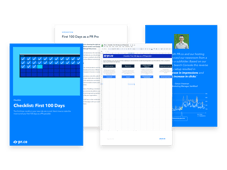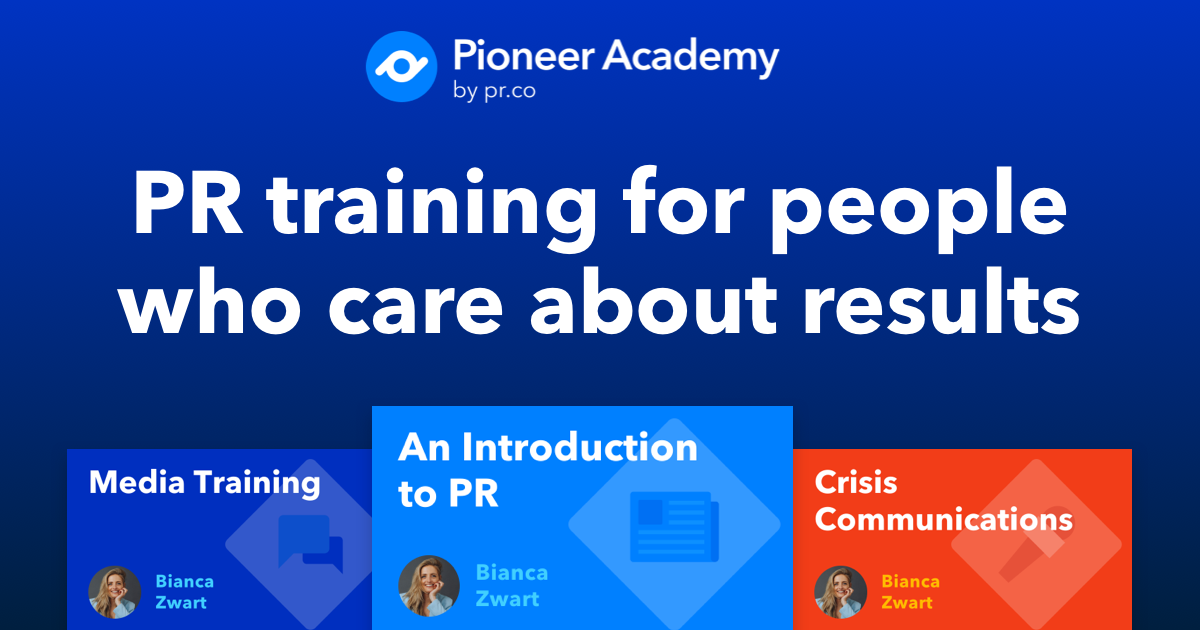When Franklin D. Roosevelt was elected into office in 1932, he inherited the worst economic crisis of the United States (at the time) - the Great Depression. With unprecedented speed, he began taking action and laying the groundwork which would determine the success of his first term in the White House. President Roosevelt coined the term “first 100 days” which later gained symbolic significance as it defines the importance of the initial period in a new role.
Regardless of the job you are starting, the first three months are crucial because they determine your overall performance in months to come. To help you jumpstart this stage of your career, we sat down with two PR specialists: Madeline Ana Vidak, PR & Communications Specialist at fast-growing scale-up EVBox, and Ross Burki, PR executive at PR agency PR Lab. They walked us through the first three months on the job and how to make a good impression.
The first 100 days are all about adjusting to a new environment and planning strategically for your first small wins. This period usually consists of three stages:
-
Listening: how do things work around here?
-
Planning: what should I be doing?
-
Executing: how do I land my first small win?
 First 100 days Checklist
First 100 days ChecklistDownload the checklist
Want to save this guide for later?
We use your contact information only to contact you about our products and services.
We never pass your information on to third parties. You can easily unsubscribe anytime.Listening: how do things work around here?
Once the dust has settled from popping champagne and updating your LinkedIn status, it’s time to officially step into your new role. The first thing you should do is get to know your company. In order to align your actions with the company’s strategic plan, you must start with the basics. Before calling any shots, begin by listening and observing your surroundings.
Purpose: Finding the company’s pulse
Every story you’ve ever heard of an entrepreneur has a superhero narrative embedded into it. It starts with an idea to make something new, better, faster, more efficient. The entrepreneur story includes everything from the many sleepless nights and series of unfortunate events, to the lucky (and perfectly timed) pivots that create happy endings. Take EVBox as an example. What first began as a vision to provide smart and scalable charging infrastructure for emission-free transportation, has now turned into 150,000+ charging points across 70+ countries. They are now leading the way towards sustainable mobility around the world.
It all starts with the deep desire to change something in the world: purpose. What positive change does your organization want to initiate? A good way to find out is by having coffee with the founder. Chatting with them will allow you to (re)discover the lifeblood of the company. As a communications specialist, your job consists of guarding your company’s purpose and making it central to how you communicate it to others. If reaching them is complicated, sit down with some of the most experienced workers on your team to find out what makes your company’s DNA so unique.
“First get to know the company you're working for. Not necessarily the product, instead, focus on people. Learn about the story that you want to bring across, and really invest time in this before you can come up with any strategies.” - Madeline
You’ll be surprised to find that your intrinsic motivation is deeply tied to your company’s purpose. Here is why purpose matters so much to communications professionals.
Understanding the structure
How do things work around here? Who calls the shots? To understand the mechanics behind your team’s work, dive into your company’s structure. How is the communications department set up? How does my PR team contribute? Besides the practical information, like organizational charts, one way to get a glimpse of reality is through your colleagues. Have a casual chat over coffee to get a grasp of their key responsibilities and work style. Don’t forget to slide in one or two personal questions. By creating rapport early on, your teammates are bound to give you the inside scoop of how things work around the office.
“In the first period, it’s important to take the time to really understand how people work and adapt to it. I think that's the only way to do it. If you were to come in, guns blazing, and try to shape the culture of a company or change how people work together, it just wouldn’t work. You're just going to draw the ire of your team and probably fail. So it's more about seeing how everybody works together and then finding your own way of delivering.” - Ross
.jpg?width=736&name=Listening%20-%20Mimi%20Thian%20Unsplash%20(1).jpg)
Determining your strategy
If the company mission is what you stand for and the vision is where you want to go, your strategy is how you get there. In order to be successful in your new role, your efforts must align with the goals the company has set out before you. Don’t criticize and resist the urge to form opinions about how things are done. Just raise questions, and give yourself some time to build a well-substantiated opinion: every company works differently.
Landing in an organization that has yet to build a proper communications strategy? Exciting, you better roll up your sleeves! We recently put together an easy-to-follow template to create your very own communications strategy, especially one that is aligned with purpose. Download it for free.
Setting expectations
To make sure both ends are on the same page, clear expectations should be set. No matter how well you think you understand what your responsibilities are, having an explicit conversation with your superior is always a good call. Remember that the first 100 days on the job are when feedback loops are established. Having a clear roadmap will allow you to build positive momentum in your role.
“In the first week at EVBox, my manager Job Karstens, scheduled a daily 30 minute meeting with me just to discuss what I was working on, what I didn’t understand, and if I had any questions. This was so helpful for me, especially since I came from a background in other industries. After that, the daily meetings turned into weekly ones. I know I can still come in with any questions and figure out what the next steps are.” - Madeline
Planning: what should I be doing?
After you’ve gotten a glimpse of your company’s structure, purpose, and strategy, the next step is to begin planning your future actions. Transitions should be smooth but they are vulnerable to missteps that can set you up for failure. Thankfully, a little planning goes a long way.
Analyzing tools
Begin your planning by getting an overview of the tools that are currently being used in your department, and get access to those tools. What should you look for? Start off by checking what software is being used and get familiar with it. Schedule a quick chat with the tool’s expert in the company for a walk-through to speed up the learning process. We might add that using a password manager will save you some trouble by allowing easy and secure access to everything you might need.
Could your organization use some new tools? After ten years of conversations with our customers, we’ve picked up a thing or two about powerful SaaS tools. Curious to see which ones made the cut? Check out our software guide.
Another question to ask is: does your company have a press page? A press page is the public face of your brand. It allows you to create a two-way relationship with the media by making your news easy to find. It creates inbound press requests and increases the chances of your pitches getting picked up. Here are three more reasons why your company shouldn’t skimp when it comes to visibility.
“One of my first tasks on the job was to analyse the tools that were being used for PR in the company. We did a lot of demos and research until we found tools that allow us to measure our results - which is always a bit tricky in this field. We already had a newsroom, which serves as an information pool for journalists who want to reach out to us. Because localisation is key in PR, we have added new newsrooms in different markets. Besides this, we also do media clippings which allows us to keep track of our mentions and also provides lots of content for internal communications”. - Madeline
Setting goals
Is there a strategy for the short-term and long-term? How does your role tie into that? One way to start is by finding low-hanging fruit. Identify some of the small changes you can initiate that will establish your credibility right off the bat. Ask the marketing/comms team what can be improved. Is there anything out there that they have been wanting to do for ages but haven’t gotten around to it yet? Being curious and proactive will always make a good impression.
“Part of our culture at PR Lab is not being afraid to have new ideas and always sharing them. So at the beginning, even when they were small, there was never any pushback from sharing your own ideas. Even though I was still trying to adapt and learn the culture, I knew that if I had an idea, it was allowed for.” - Ross
Executing: how do I land my first small win?
.jpg?width=1616&name=danielle-macinnes-IuLgi9PWETU-unsplash%20(1).jpg)
Start with small wins
The first 100 days should be used to lay the foundation for long-term effects. But how? you may ask. Well, it’s all about small wins. Achieving specific goals will pave the way for bigger milestones ahead. Securing small, yet substantive, wins will also build momentum for positive change and help you establish credibility with your peers.
Beware! In your eagerness to please, achieve and succeed you might catch yourself taking on too many tasks. The key to success is by staying focused on 3 or 4 specific and measurable objectives.
“My first big project as a PR specialist was to write a press release about an upcoming milestone in the company. My manager really pushed me and motivated me to reach out to stakeholders. I had never really approached senior management in my previous jobs for smaller companies. I could advise not to be afraid of senior people in the company. Because as soon as they see some results they will appreciate it as well, and understand how important it is.” - Madeline
Asking for help
Hey, you’re only human. Mistakes are going to happen. Remember that part of being self-aware is knowing when you need to ask for help. You might stumble during your first 100 days until you get the hang of it. As cheesy as it may sound, if you fall down seven times, stand up eight.
“Be confident. If you got the job, it should say enough about your skills. Take the time to ask questions and also trust yourself when you know what you can do.” - Ross
“Be proactive. People who work in PR tend to be very enthusiastic kickstarters. Don’t be afraid to receive criticism because there will be tons of it in your job. You will find your way in this industry if you are open to tips and feedback. To do so, talk to people and show them you are interested in them. It will really boost your work in the long run.” - Madeline

Madeline Ana Vidak is a PR and communications specialist at EVBox. Besides coordinating and executing PR projects and events on a global scale, she handles media relations and works closely with external PR agencies.
Ross Burki, a former freelance writer, recently joined Amsterdam based PR agency, PR Lab, as an account executive. His role is to create engaging stories and impactful content for leading tech companies.
Ana is a marketer at pr.co, and is the driving force behind our 100+ articles and guides. Ana has an MSc in Corporate Communications, and four years of experience in the PR industry. Now, Ana distills knowledge from pr.co’s 250+ customers to help PR professionals get better results through high-quality content.. Connect on LinkedIn or send an email





.jpg?width=1466&name=blog-cta-softwareguide%20(alt).jpg)
